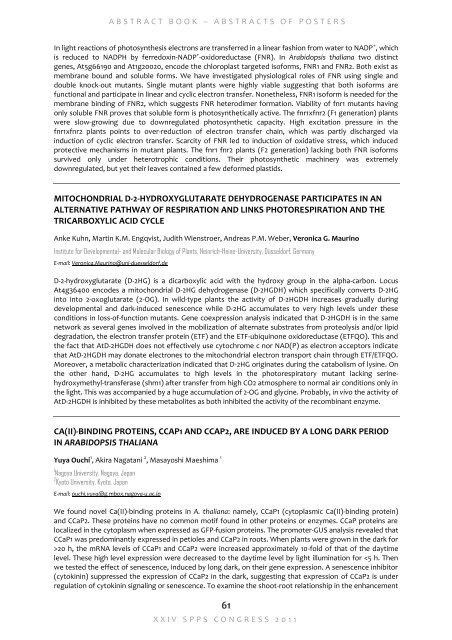1. Front Cover.cdr - CORE
1. Front Cover.cdr - CORE
1. Front Cover.cdr - CORE
Create successful ePaper yourself
Turn your PDF publications into a flip-book with our unique Google optimized e-Paper software.
A B S T R A C T B O O K – A B S T R A C T S O F P O S T E R S<br />
In light reactions of photosynthesis electrons are transferred in a linear fashion from water to NADP + , which<br />
is reduced to NADPH by ferredoxin-NADP + -oxidoreductase (FNR). In Arabidopsis thaliana two distinct<br />
genes, At5g66190 and At1g20020, encode the chloroplast targeted isoforms, FNR1 and FNR2. Both exist as<br />
membrane bound and soluble forms. We have investigated physiological roles of FNR using single and<br />
double knock-out mutants. Single mutant plants were highly viable suggesting that both isoforms are<br />
functional and participate in linear and cyclic electron transfer. Nonetheless, FNR1 isoform is needed for the<br />
membrane binding of FNR2, which suggests FNR heterodimer formation. Viability of fnr1 mutants having<br />
only soluble FNR proves that soluble form is photosynthetically active. The fnr1xfnr2 (F1 generation) plants<br />
were slow-growing due to downregulated photosynthetic capacity. High excitation pressure in the<br />
fnr1xfnr2 plants points to over-reduction of electron transfer chain, which was partly discharged via<br />
induction of cyclic electron transfer. Scarcity of FNR led to induction of oxidative stress, which induced<br />
protective mechanisms in mutant plants. The fnr1 fnr2 plants (F2 generation) lacking both FNR isoforms<br />
survived only under heterotrophic conditions. Their photosynthetic machinery was extremely<br />
downregulated, but yet their leaves contained a few deformed plastids.<br />
MITOCHONDRIAL D-2-HYDROXYGLUTARATE DEHYDROGENASE PARTICIPATES IN AN<br />
ALTERNATIVE PATHWAY OF RESPIRATION AND LINKS PHOTORESPIRATION AND THE<br />
TRICARBOXYLIC ACID CYCLE<br />
Anke Kuhn, Martin K.M. Engqvist, Judith Wienstroer, Andreas P.M. Weber, Veronica G. Maurino<br />
Institute for Developmental- and Molecular Biology of Plants, Heinrich-Heine-University, Düsseldorf, Germany<br />
E-mail: Veronica.Maurino@uni-duesseldorf.de<br />
D-2-hydroxyglutarate (D-2HG) is a dicarboxylic acid with the hydroxy group in the alpha-carbon. Locus<br />
At4g36400 encodes a mitochondrial D-2HG dehydrogenase (D-2HGDH) which specifically converts D-2HG<br />
into into 2-oxoglutarate (2-OG). In wild-type plants the activity of D-2HGDH increases gradually during<br />
developmental and dark-induced senescence while D-2HG accumulates to very high levels under these<br />
conditions in loss-of-function mutants. Gene coexpression analysis indicated that D-2HGDH is in the same<br />
network as several genes involved in the mobilization of alternate substrates from proteolysis and/or lipid<br />
degradation, the electron transfer protein (ETF) and the ETF-ubiquinone oxidoreductase (ETFQO). This and<br />
the fact that AtD-2HGDH does not effectively use cytochrome c nor NAD(P) as electron acceptors indicate<br />
that AtD-2HGDH may donate electrones to the mitochondrial electron transport chain through ETF/ETFQO.<br />
Moreover, a metabolic characterization indicated that D-2HG originates during the catabolism of lysine. On<br />
the other hand, D-2HG accumulates to high levels in the photorespiratory mutant lacking serinehydroxymethyl-transferase<br />
(shm1) after transfer from high CO2 atmosphere to normal air conditions only in<br />
the light. This was accompanied by a huge accumulation of 2-OG and glycine. Probably, in vivo the activity of<br />
AtD-2HGDH is inhibited by these metabolites as both inhibited the activity of the recombinant enzyme.<br />
CA(II)-BINDING PROTEINS, CCAP1 AND CCAP2, ARE INDUCED BY A LONG DARK PERIOD<br />
IN ARABIDOPSIS THALIANA<br />
Yuya Ouchi 1 , Akira Nagatani 2 , Masayoshi Maeshima 1<br />
1 Nagoya University, Nagoya, Japan<br />
2 Kyoto University, Kyoto, Japan<br />
E-mail: ouchi.yuya@g.mbox.nagoya-u.ac.jp<br />
We found novel Ca(II)-binding proteins in A. thaliana: namely, CCaP1 (cytoplasmic Ca(II)-binding protein)<br />
and CCaP2. These proteins have no common motif found in other proteins or enzymes. CCaP proteins are<br />
localized in the cytoplasm when expressed as GFP-fusion proteins. The promoter-GUS analysis revealed that<br />
CCaP1 was predominantly expressed in petioles and CCaP2 in roots. When plants were grown in the dark for<br />
>20 h, the mRNA levels of CCaP1 and CCaP2 were increased approximately 10-fold of that of the daytime<br />
level. These high level expression were decreased to the daytime level by light illumination for


